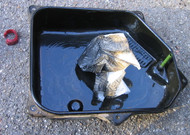Transmission Fluid Change vs Flush: What's the Difference?
9th Apr 2019

Understanding Transmission Fluid Changes and Flushes
Transmission fluid changes and flushes are two different automotive services involving a vehicle's transmission fluid. If you're guilty of neglecting your vehicle's transmission, you might be wondering which is one to choose. Both services will remove your vehicle's old transmission fluid and replace it with new fluid. A transmission fluid change isn't the same as a flush, however, and it's important to understand the differences between these two services to determine which one is right for your vehicle.
Transmission Fluid Change Explained
A transmission fluid change is the same as an oil change -- only it involves transmission fluid rather than engine oil. During a transmission fluid change, the mechanic will place a large pan underneath your vehicle's transmission and then remove the drain plug to drain the fluid.
The mechanic will likely use this opportunity to replace the transmission filter as well, which is essential to protecting your vehicle's transmission from impurities and pollutants that could otherwise shorten its lifespan.
After draining the transmission and replacing the filter, the mechanic will refill your transmission with an appropriate amount of fluid (12 to 16 quarts for most vehicles).
Transmission Fluid Flush Explained
A transmission fluid flush, on the other hand, is a more complex service that involves hooking your vehicle's transmission up to a vacuum machine to extract the transmission fluid. Using this machine, the mechanic can remove 100% of your vehicle's transmission fluid to ensure there's no dirty or contaminated fluid lingering inside the transmission.
If you opt for a transmission fluid, you can rest assured knowing that all of your vehicle's old transmission fluid is being removed. With a transmission fluid change, only about 30% to 50% of the old fluid will be removed.
Some automotive experts caution against transmission fluid flushes on old vehicles with worn and degraded transmissions. The belief is that flushing will remove the metal shavings mixed in the fluid that's essentially holding the transmission's gears together. Unless your vehicle is particularly old, though, this shouldn't be a concern.
To determine whether your vehicle needs a transmission fluid change or flush, refer to your owner's manual. Most automakers recommend changing the transmission fluid at least once every 30,000 to 50,000 miles and flushing the transmission fluid at least once every 60,000 to 100,000 miles. Of course, you should check your owner's manual and follow the recommendations listed by your vehicle's manufacturer.


